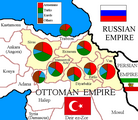Sechs Vilâyets

Die Sechs Armenischen Vilâyets oder Sechs Provinzen (osmanisch ولايت سته İAVilâyat-ı Sitte; armenisch Վեց հայկական վիլայեթներWez’ hajkakan wilajet'ner; modernes türkisch Altı vilâyet, Altı Ermeni ili[1]) waren die armenisch bevölkerten Provinzen (Vilâyets) des Osmanischen Reiches:
Der Begriff Sechs Armenische Provinzen wurde erstmals auf dem Kongress von Berlin von 1878 verwendet. Auch wenn die Armenier spätestens im 20. Jahrhundert in keinem Vilâyet mehr die Bevölkerungsmehrheit stellten (allerdings in einigen Regionen die größte Bevölkerungsgruppe) war diese Region als Westarmenien bis zum Völkermord an den Armeniern 1915 das Hauptsiedlungsgebiet der Armenier neben Ostarmenien (das Gebiet der heutigen Republiken Armenien und Arzach in Bergkarabach).
Bevölkerung
Volksgruppen

Verschiedene Versionen über die Bevölkerungsstatistiken werden unten angezeigt.
Armenisches Patriarchat von Konstantinopel 1912:[2]
Die Analyse schließt bestimmte Teile dieser Provinz aus, in denen die Armenier nur einen sehr kleinen Anteil bildeten. Diese Teile waren folgende: um Hakkâri im Vilâyet Van; südöstlich von Siirt im Vilâyet Bitlis; der Süden des Vilâyets Diyarbakır; der Süden von Malatya im Vilâyet Mamuretül-Aziz; der Nordwesten und Westen des Vilâyets Sivas.[3][4]
| Ethnie | Bitlis | Diyarbakır | Erzerum | Mamuretül-Aziz | Sivas | Van | Gesamt | Anteil |
|---|---|---|---|---|---|---|---|---|
| Armenier | 180.000 | 105.000 | 215.000 | 168.000 | 165.000 | 185.000 | 1.018.000 | 38,9 % |
| Türken1 | 48.000 | 72.000 | 265.000 | 182.000 | 192.000 | 47.000 | 806.000 | 30,8 % |
| Kurden2 | 77.000 | 55.000 | 75.000 | 95.000 | 50.000 | 72.000 | 499.000 | 19,1 % |
| Andere3 | 30.000 | 64.000 | 48.000 | 5.000 | 100.000 | 43.000 | 290.000 | 11,1 % |
| Gesamt | 382.000 | 296.000 | 630.000 | 450.000 | 507.000 | 350.000 | 2.615.000 | 100 % |
1 ohne Kizilbasch | ||||||||
Offizielle osmanische Volkszählung 1914:[5]
Die Osmanische Volkszählung gibt keine Information über verschiedene muslimische Volksgruppen wie Türken, Kurden, Tscherkessen etc.
Die meisten westlichen Gelehrten stimmen darin überein, dass die offizielle osmanische Volkszählung die Zahl der ethnischen Minderheiten unterschätzt, darunter die Anzahl der Armenier.[6] Faktisch definierte die osmanische Volkszählung keine einzige Volksgruppe, nur Religionsgruppen. So bedeutete Armenier, Anhänger der armenisch-apostolischen Kirche. Ethnische Armenier, die sich als Muslime bezeichneten, wurden als Muslime gezählt, Armenische Protestanten wiederum als andere.
| Ethnie | Bitlis | Diyarbakır | Erzerum | Mamuretül-Aziz | Sivas | Van | Gesamt | Anteil |
|---|---|---|---|---|---|---|---|---|
| Muslime | 309.999 | 492.101 | 673.297 | 446.376 | 939.735 | 179.380 | 3.040.888 | 79,6 % |
| Armenier | 119.132 | 65.850 | 136.618 | 87.862 | 151.674 | 67.792 | 628.928 | 16,5 % |
| Andere | 44.348 | 4.020 | 5.797 | 4.047 | 78.173 | 11.969 | 148.354 | 3,9 % |
| Gesamt | 473.479 | 561.971 | 815.712 | 538.285 | 1.169.582 | 259.141 | 3.818.170 | 100 % |
- Maps
- Armenische Bevölkerung, 1893–1896
- Ethnische Karte der Sechs Vilâyets (Westarmenien) gemäß dem Armenischen Patriarchat von Konstantinopel 1912
- Armenische Bevölkerung in den sechs Vilâyets.
Einzelnachweise
- ↑ İsmail Soysal: Türkiye’nin Siyasal Andlaşmaları. I. Cilt (1920–1945), Türk Tarih Kurumu, 1983, S. 14 (türkisch).
- ↑ James Viscount Bryce: The Treatment of Armenians in the Ottoman Empire 1915-1916. T. Fisher Unwin, London 1916.
- ↑ Justin McCarthy: Muslims and Minorities: The Population of Ottoman Anatolia and the End of the Empire. New York University Press, 1983, ISBN 0-87150-963-6, S. 56–59.
- ↑ Servet Mutlu: Late Ottoman Population And Its Ethnic Distribution. In: Turkish Journal of Population Studies. 25. Jahrgang, Nr. 1. Nüfusbilim Dergisi, 2003, S. 21 (hips.hacettepe.edu.tr ( des vom 18. September 2015 im Internet Archive) [abgerufen am 3. November 2011]): „There is no evidence supporting the Patriarch’s numbers. Conceivably they could have been based on church registers. But to date, neither any local church register nor any document showing the summation of local registers at the Patriarchate in İstanbul has been produced as proof (McCarthy, 1998a, S. 56–59). More important, even if such records of the Armenian population existed, how could the local priests, and hence the Patriarch who would be getting his numbers from them, ever know how many Muslims existed short of a census. Yet, the census figures belie the Patriarch’s. Hence, the Patriarch’s figures were nothing but politically motivated constructions.“ Info: Der Archivlink wurde automatisch eingesetzt und noch nicht geprüft. Bitte prüfe Original- und Archivlink gemäß Anleitung und entferne dann diesen Hinweis.
- ↑ T.C. Genelkurmay Başkanliği, Ankara. ( vom 7. Oktober 2011 im Internet Archive; PDF) Arşiv Belgeleriyle Ermeni Faaliyetleri 1914–1918, Cilt I. Armenian Activities in the Archive Documents 1914–1918, Volume I, S. 603–628. (Volkszählungsstatistiken 1914, Herausgeber: Generalstab der Türkei)
- ↑ „[…] indicates (based on 1919 British estimates) that though Ottoman data were generally reliable they did underestimate the Armenian population in 1914 […]“. Steven T. Katz: The Holocaust in Historical Context. Band 1: The Holocaust and Mass Death before the Modern Age. Oxford University Press, New York / Oxford 1994, ISBN 0-19-507220-0, S. 86.
Auf dieser Seite verwendete Medien
Map of the Armenian population in the Six Vilayet in 1896.
According to the information of this map:
http://en.wikipedia.org/wiki/File:Armenian_population_map_1896.jpgAutor/Urheber: Underlying lk, Lizenz: CC BY-SA 3.0
XY Vilayet, Ottoman Empire (1900). Source: An Economic and Social History of the Ottoman Empire, Volume 2 at Google Books By Suraiya Faroqhi, Bruce McGowan, Donald Quataert, Sevket Pamuk
The Ottoman Empire population census document regarding the census established between 1893-1897. First column "musulmans" (Muslims), second "grecs" (Greeks), third "arméniens" (Armenians)
The Ottoman Empire archive document regarding the official census of 1914. first column "musulman" (muslims) total pop: 14,155,755**, second "grecs" (Greeks), third "arménien" (Armenians) total pop: 1,219,323







